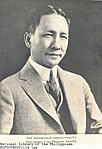1922 Philippine Senate elections
| ||||||||||||||||||||||
11 of the 24 seats in the Philippine Senate | ||||||||||||||||||||||
|---|---|---|---|---|---|---|---|---|---|---|---|---|---|---|---|---|---|---|---|---|---|---|
| ||||||||||||||||||||||
 Election results; each district sent in two seats to the Senate. | ||||||||||||||||||||||
| ||||||||||||||||||||||
Senatorial elections were held on June 6, 1922 in the Philippines under the Jones Law provisions. It was controversial when Senate President Manuel L. Quezon accused Sergio Osmeña of autocratic leadership and for his failure in handling the economic crisis which began in 1919. This resulted to the Nacionalista Party to be split.[1]
Quezon-Osmeña spilt
[edit]In 1921, the economic crisis that began in 1919 began to worsened in the Philippine Islands. From 1919 to 1921, there were floods in parts of the country resulting in a rice crisis. The Philippine National Bank lost 38 million Philippine pesos due to mismanagement and the government deficit was more than 7 million pesos which led to the raising of taxes. During these period, all government-owned corporations suffered losses. The economic crisis led to massive discontent and criticism to the standing party, the Nacionalista Party.[1]
When Warren G. Harding, then elected U.S. president, sent the Wood-Forbes Mission for the Philippine Islands in April 1921, Quezon became worried of Osmeña's autocratic party leadership. The mission's aim was to investigate the economic and political situation in the islands. For Quezon, Osmeña's leadership would harm the Nacionalista Party due to the financial mess of the Philippine National Bank.[1]
After the Wood-Forbes report was published, Quezon publicly campaigned against Osmeña. He stated that ever since the establishment of the Philippine government under the Jones Act, the Legislature and the Cabinet put Osmeña direct control of the Philippines' legislation and administration of public affairs. Appointments made by department secretaries to the Governor-General were "made upon Osmeña's initiative" or with his consent. He also blamed him for the Philippine National Bank's financial mess. In response to the leadership issue, in December 1921, Osmeña resigned for the speakership. That same month, representatives approved a resolution expressing confidence to Osmeña's leadership in government, the senate did not take action.[1]
The Council of Ten was then created to conciliate the two. Since most of its members were pro-Osmeña lawmakers, Quezon resigned as Senate President in January 1922. Osmeña reacted to this by begging him to withdraw his resignation. The debate between Osmeña and Quezon continued until February 1922. Due to the severity of the leadership crisis, Osmeña also resigned as Nacionalista Party leader with reluctance from its members. In February 17, 1922, Quezon formed the Partido Nacionalista Colectivista in Manila.[1]
Electoral system
[edit]In a staggered election, the seats of the senators who were first place in 1916 were up for election. The Philippines is divided into 12 senatorial districts, of which all districts save for the 12th district, has one of its seats up. In the 12th district, any vacancy is filled via appointment of the Governor-General. The election itself is via first-past-the-post.
Results
[edit]
|
| Party | Seats | |||||
|---|---|---|---|---|---|---|
| Up | Before | Won | After | +/− | ||
| Nacionalista Party[a] | 10 | 20 | 8 | 18 | −2 | |
| Democrata Party | 0 | 1 | 3 | 4 | +3 | |
| Progresista Party | 1 | 1 | 0 | 0 | −1 | |
| Appointed[b] | 0 | 2 | 0 | 2 | 0 | |
| Total | 11 | 24 | 11 | 24 | 0 | |
- ^ The Nacionalista Party won 8 seats: 5 seats under the Colectivistas and 3 seats under the Unipersonalistas. Following the election, the Nacionalista Party has a total of 18 seats: 12 seats under the Colectivistas and 6 seats under the Unipersonalistas.
- ^ At the time of the election, the two appointed senators were from the Democrata Party.


